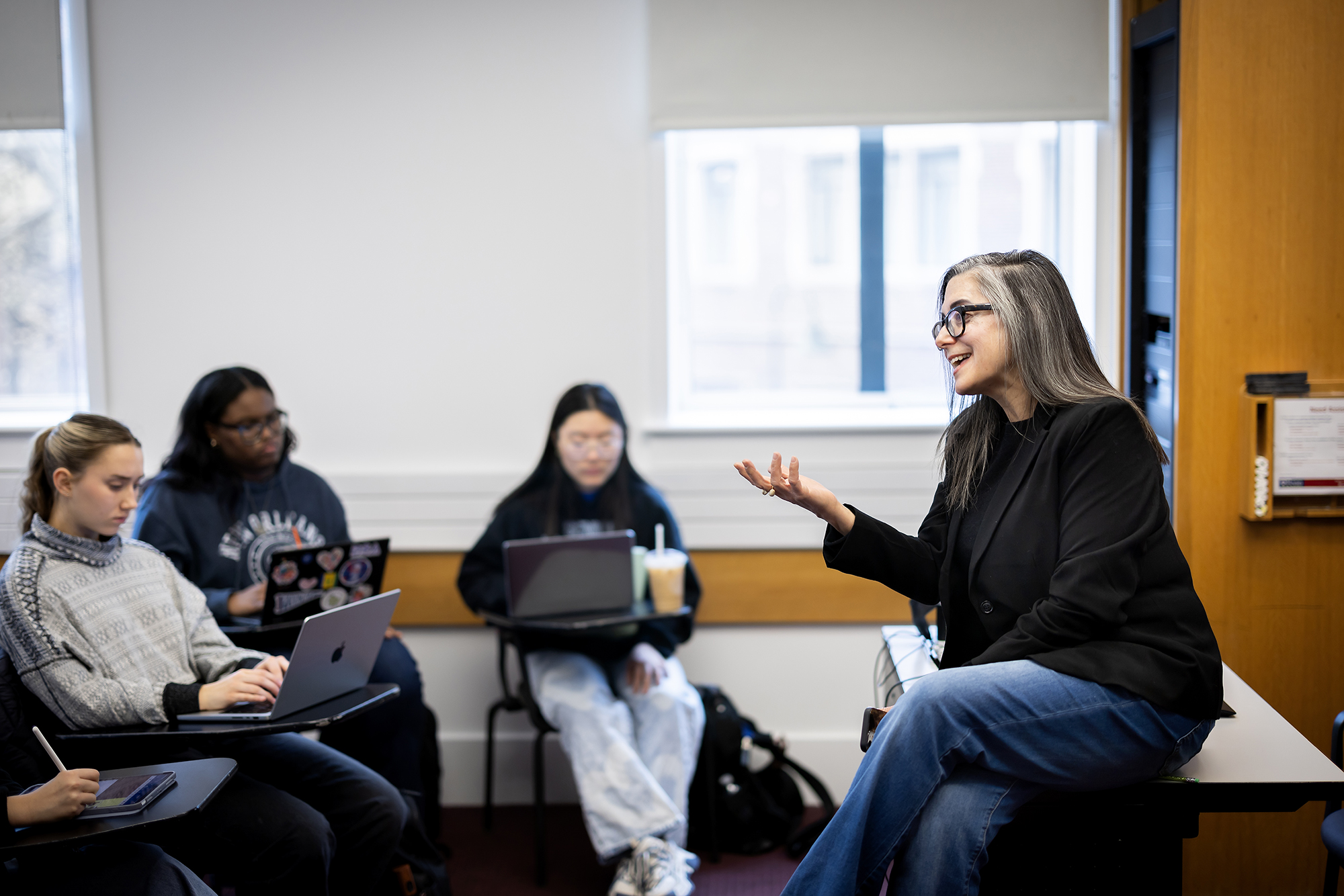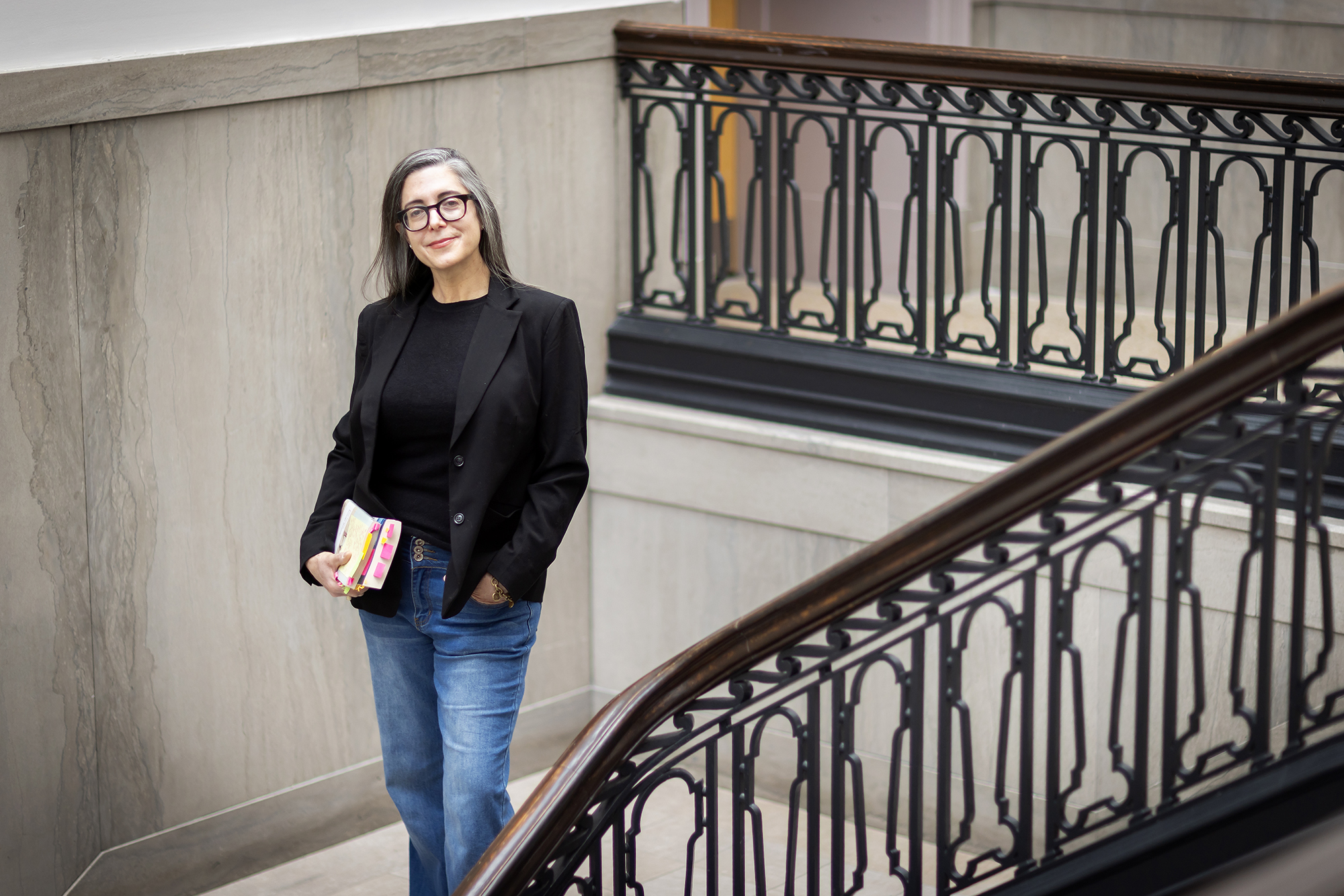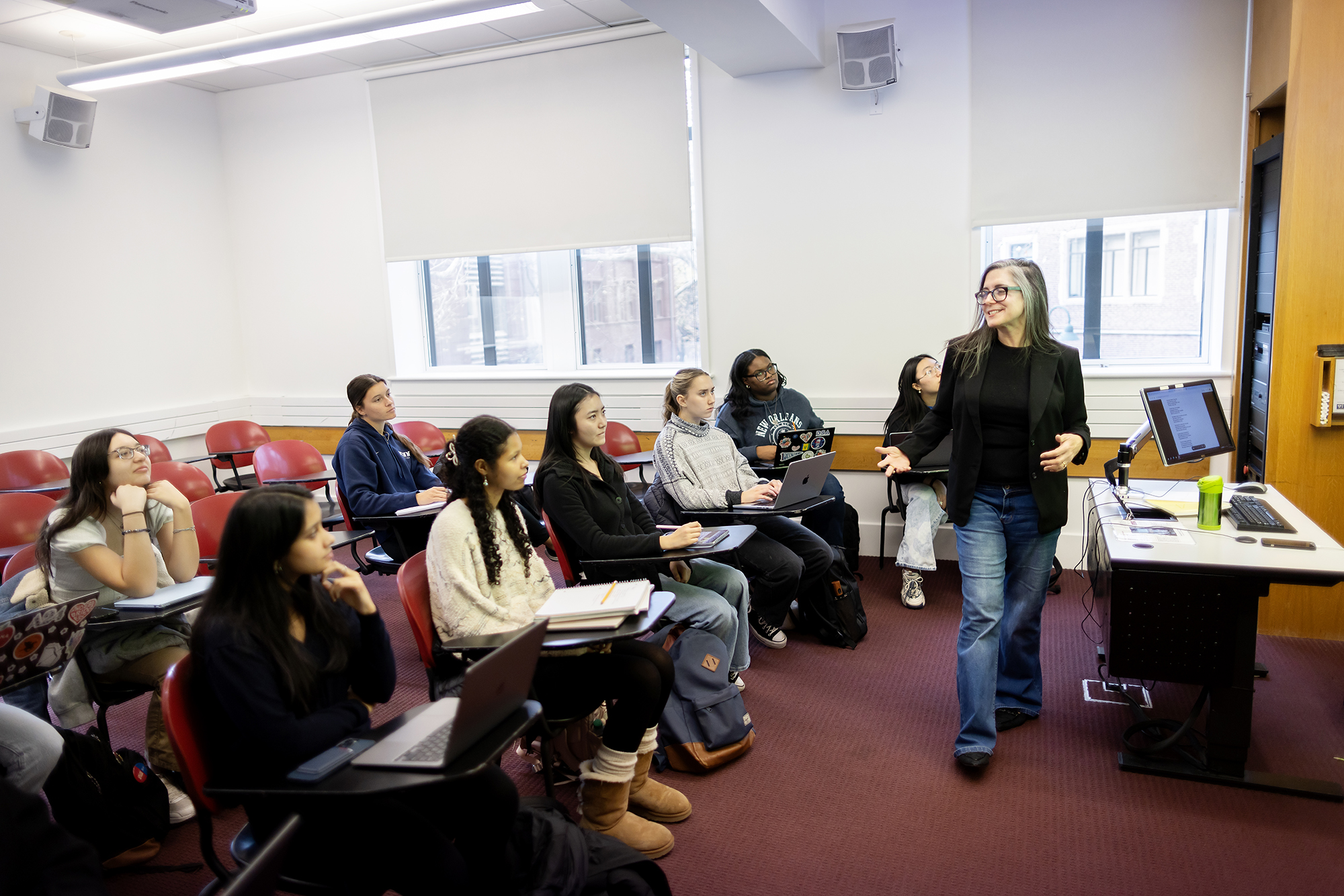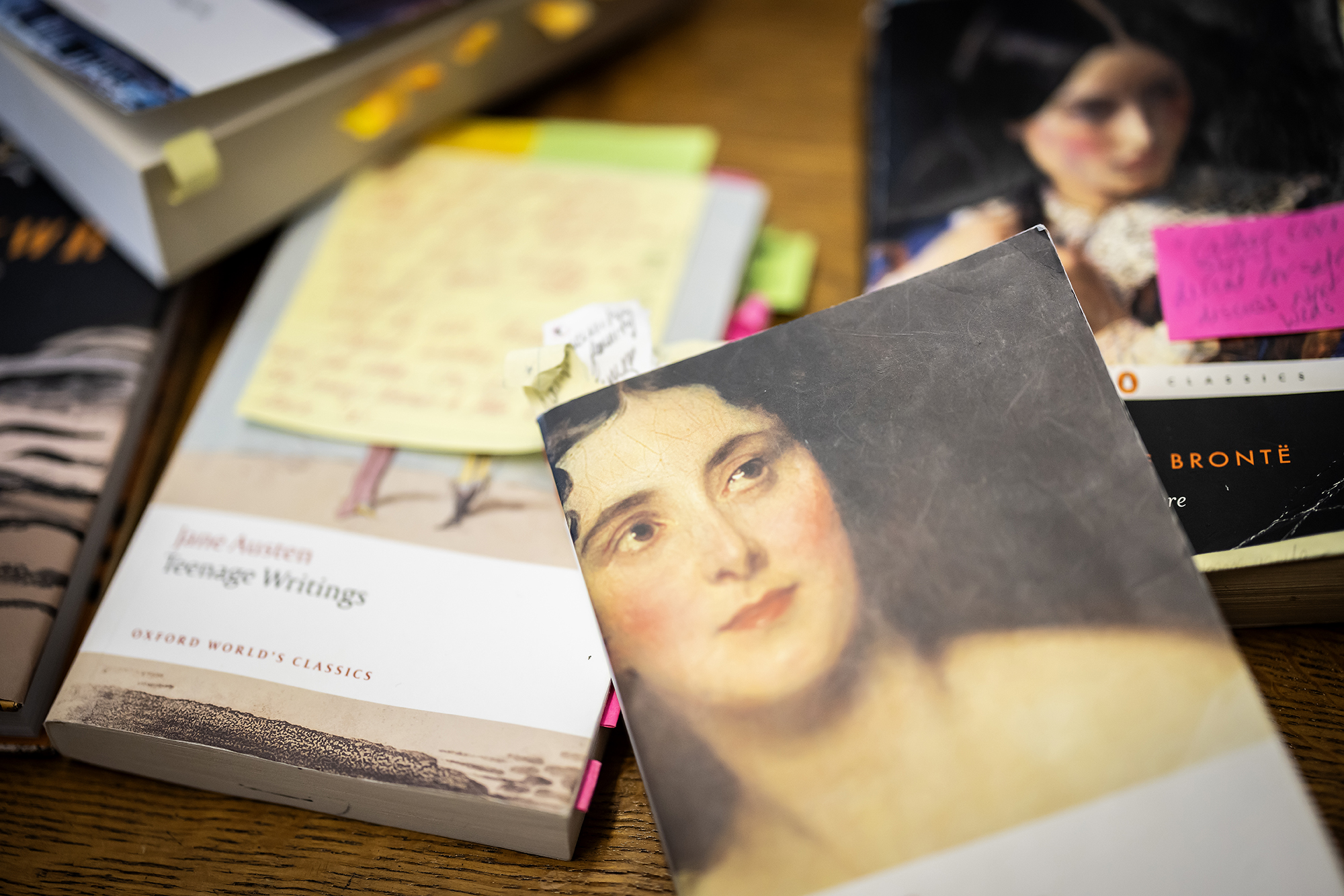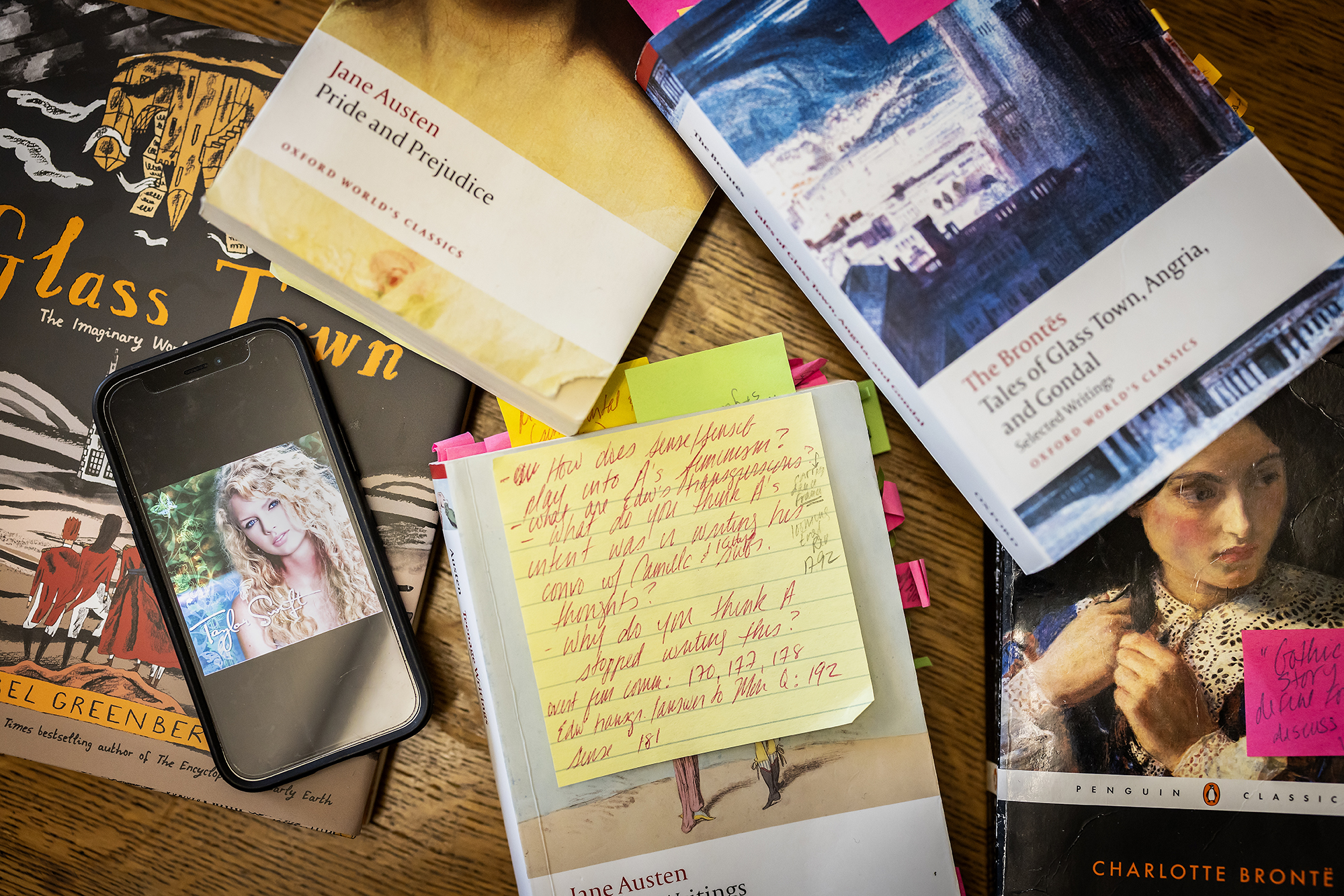
Modern-day superstar songwriters Taylor Swift and Chance the Rapper have much in common with 18th- and 19th-century superstar novelists Jane Austen and Charlotte Brontë. Although writing 200-plus years apart, these and other creators showed great promise when they were young, producing remarkable works before the age of eighteen, as Penn students found in Juvenilia, a new first-year English course in the fall semester.
“I was thinking about the fact that a lot of these creators and influencers and important writers and musicians were the same age as my students, or younger, when they started out,” says Melissa Jensen, who has taught English and writing at Penn for 15 years. Rather than use these early works as adjuncts to other studies, she thought, “Why not concentrate on it?”
Jean-Christophe Cloutier, undergraduate chair of the English Department, says that when Jensen proposed Juvenilia, he immediately wanted it be a first-year seminar, saying “the unique beauty” of the course is that students would encounter writings composed by authors who were about their age at the time.
“What’s it like to read what Jane Austen was writing when she was my age? How does this compare to, say, Taylor Swift’s earliest lyrics?” says Cloutier, associate professor of English and comparative literature. “The potential for our students to make personal connections across time and space with major literary figures was so high that I knew we could not pass up the opportunity to offer this course.”
Jensen soon learned students were talking about the “Jane Austen-Taylor Swift” class, “which I thought was great,” she says.
Firsts
In a series of firsts, Juvenilia was a brand-new class; it was the first time Jensen had taught a first-year seminar; and the 14 students were in their first semester at Penn.
An author of young-adult novels, Jensen was an English and sociology major at Penn, graduating in 1989. She earned her graduate degree from the Fels Institute of Government in 1993. She later joined the English Department faculty, teaching her first course in the fall of 2009, Writing for T(w)een Readers.
Jensen has taught numerous other courses on children’s and young-adult literature, many with engaging names, including Modern Children’s Literature: Radiant, Humble, Monstrous and Young Adult Literature: The Eternal Awkward. This spring semester Jensen is teaching Frightful: Adolescence and the Gothic and Terrifying: Adolescence, Real and Imagined.
“Melissa is an award-winning teacher whose courses are consistently overenrolled and universally beloved,” Cloutier says. “She is herself so clearly a fan of what she teaches—whether it be children’s lit, young adult, the gothic, or juvenilia—and this love is irreplaceable. You can feel that love whenever Melissa speaks about literature, and the exceptional quality of her passion has been critical to our students.”
Nathalie Mejia, a first-year in the College of Arts and Sciences from Phoenix planning a pre-med major in biology or public health, says Jensen “wholeheartedly embraces connecting popular culture,” and that they talked about “gender and class, freedom and uprising,” in class, tying those themes into adolescence.
“One day we are trying to make sense of Brontë’s multifaceted world-building, and the next we are in the Kislak Center getting to look at the first and second editions of (Phillis) Wheatley’s work. Now, we’re connecting the dots, analyzing someone influential from our time—Malala’s (Yousafzai) incredible speeches and blogs—and tying it back into the discussions we had about Wheatley,” Mejia says. “While some of the pieces we reference are well-known, like ‘Jane Eyre,’ we had the opportunity to deep dive into works that don’t get the attention they deserve simply because they were written at a young age.”
Early writings
Jensen encouraged students to “connect these writings from 1787 with their lives in 2023,” she says. “The humor is the maybe the first thing they can engage with. The stories are funny, really sharp, coming from this young person. We get this hint of where Austen’s going to go.”
The class also studied Phillis Wheatley, one of the first Black and enslaved people in the United States to publish a book of poems, “Poems on Various Subjects, Religious and Moral in 1773”; and Charlotte Brontë, the eldest of three sisters in England whose novels later became classics.
“The class just did wonderfully, engaging with the work,” Jensen says. “They’ve had to think a lot about subtext and had to think about where these three women were placed in time and place.”
The early writings of other authors studied included pioneering 20th-century novelist Virginia Woolf and contemporary writer Margaret Atwood.
Kayla Williams, a first-year student in the College from Atlanta planning to major in communications, says she had not previously read the novels on the syllabus and was curious, and she wanted to incorporate writing into her first semester.
“It’s really fascinating honestly, to hear what Professor Jensen has to say about these books. And she always brings in a new viewpoint that I had never considered,” Williams says. “She also opened my eyes to new ways of thinking about writing, especially in juvenilia, since we are looking at the writing from these young people and how formative it was. She has a really good way of making connections and bridging gaps.”
Austen’s “Pride and Prejudice” and Brontë’s “Jane Eyre” and Emily Brontë’s “Wuthering Heights” and Shakespeare’s “Romeo and Juliet” Jensen says are familiar, woven into popular culture through movies, quotes on T-shirts, and countless memes. “Fascinating culturally and sociologically,” she says, “and an opportunity, I think, for first-year students to engage with questions of humanity in literature, to engage with texts that are appealing.”
Jensen says she teaches Austen as “a proto-feminist satirist,” not as a romance novelist. “I want my students to focus on the constraints around gender that underly the classic literature of love and marriage, and to have substantial discourse around the interplay between society and literature and historicism,” she says.
Spanning centuries
The curriculum soon moved to the contemporary creators, which included many musicians. “They want to talk about Taylor Swift,” Jensen says, “and I get it.”
Why mix music with literature? “Lyrics are literature: verse set to music,” says Jensen. “At 15, it’s the music that often is the most resonant, what we’re listening to … It’s a time of a lot of firsts; a lot of kids have their first relationships, their first sexual encounters, and frenemies—this idea of negotiating, navigating social situations hits a peak.”
A first-year student in the College from Mumbai, India, Samar Shroff is planning a pre-med major in neuroscience. “I think music makes this class relatable as well because it’s all about tapping into the juvenile mind and understanding it. And song lyrics are something we might do better with than 18th-century English,” says Shroff.
The class studied Swift’s first three albums, written in her teens, and compared the lyrics with her most recent work, albums “evermore” and “folklore,” to examine how she incorporates literature in her storytelling. “We looked at songs from her first album, like ‘Love Story,’ where her use of Romeo and Juliet is youthful and romanticized, and the difference between how 15-year-old Taylor is looking at both literature and life, and what she’s doing now,” Jensen says.
Chloe Norman, a first-year student in the College from Atlanta who is planning to major in English and health and societies, says Austen is one of her favorite authors and Swift is her favorite singer. During the course, Norman says she came to realize the commonalities between them. Austen’s novels have romantic aspects but are at their heart about class and gender inequity, she says, and Swift often incorporates double standards for women in her lyrics. “So, I think in a lot of ways you can find interesting parallels between them that you wouldn't expect to find,” Norman says.
One Swift song, “Invisible String” from the 2020 “folklore” album, has a reference to Brontë’s “Jane Eyre.” Jensen says the class compared Swift’s lyric, “And isn't it just so pretty to think/ All along there was some invisible string/ Tying you to me,” with Brontë’s Mr. Rochester speaking to Jane: “I have a strange feeling with regard to you. As if I had a string somewhere under my left ribs, tightly knotted to a similar string in you. And if you were to leave I’m afraid that cord of communion would snap. And I have a notion that I'd take to bleeding inwardly. As for you, you’d forget me.”
Says Jensen: “They’re making connections between these 18th-and 19th-century writers and these 21st-century creators.”
‘Next generation’
Mejia says that if she had to choose one thing she took away from the course, “it would be to be vocal, slightly rebellious, and brave,” noting that they analyzed a variety of artists, across many mediums, but with a specific emphasis on women.
“Jane Austen and Phillis Wheatley and Taylor Swift all faced different struggles, but they were all struggles that they resonated with specifically because they felt marginalized and unheard,” Mejia says. “They were innovative in their craft at such a young age and continued to develop their style as they grew up. Looking at them as a young woman is particularly inspiring, and I want to seek out courses that encourage me to push myself and be bold as they were.”
Students were required to write and give a presentation on creators of their choice—artists, singers, authors, dancers, comedians—studying their work as juveniles and comparing it with their later work. Choices included comedian Pete Davidson, ballerina Tiler Peck, actor and director Greta Gerwig, and singers Miley Cyrus and Billie Eilish. “It was a very diverse selection of creators,” says Shroff, who chose artist Artemisia Gentileschi, a baroque painter from the 16th century.
Students completed final projects focused on parallels between a classic novelist’s later work and their adolescent writings.
“I want the students thinking about the fact that they’re 18, give or take a year, so everything they’ve done up to this point is juvenilia,” Jensen says. “I ask them: ‘How many of you cringe when you read what you wrote at nine to 15?’ And most hands go up. But I hope now that they’ll look at their early creations again somewhat differently.”
Jensen says, and she also wants these first-year students to recognize their potential. “They’re the next generation of creators, whether it's scientific, or musical, or visual arts, or literary, or journalistic,” she says. “I want them firmly placing themselves in the pantheon of creators, because they’re doing it.”




